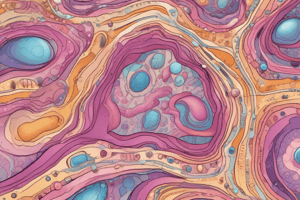Podcast
Questions and Answers
Which function does the thin sheet of tissues lining body surfaces or cavities NOT serve?
Which function does the thin sheet of tissues lining body surfaces or cavities NOT serve?
- Functions in immunity
- Serves as a barrier
- Anchors organs in place
- Secretes various substances (correct)
What is the main function of mucous membranes (mucosae)?
What is the main function of mucous membranes (mucosae)?
- Transport nutrients
- Protect underlying tissue with mucus (correct)
- Generate heat
- Lubricate the skin
What characterizes the cutaneous membrane?
What characterizes the cutaneous membrane?
- Is also called mucosae
- Includes the epidermis and dermis (correct)
- Consists of mesothelium layers
- Lines joint cavities
Which type of membrane lines the pleural, pericardial, and peritoneal body cavities?
Which type of membrane lines the pleural, pericardial, and peritoneal body cavities?
What fluid lubricates joint cavities lined by synovial membranes?
What fluid lubricates joint cavities lined by synovial membranes?
What is the main difference between parietal and visceral layers of serous membranes?
What is the main difference between parietal and visceral layers of serous membranes?
What supports the mesothelium in serous membranes?
What supports the mesothelium in serous membranes?
Which type of membrane serves to protect underlying tissues with mucus?
Which type of membrane serves to protect underlying tissues with mucus?
What two layers make up synovial membranes?
What two layers make up synovial membranes?
What is the role of synovial fluid in synovial membranes?
What is the role of synovial fluid in synovial membranes?
Flashcards are hidden until you start studying
Study Notes
General Terms
- Tissue: A specialized collection of cells performing specific functions.
- Histology: The study of normal tissue structures.
- Four basic tissue types: Epithelial, connective, muscle, nervous.
Extracellular Matrix (ECM)
- Composed of substances in liquid, gel, or solid form surrounding tissue cells.
- ECM components: Ground substance and protein fibers.
- Three types of protein fibers:
- Collagen fibers: Provide tensile strength.
- Elastic fibers: Allow tissues to stretch and recoil.
- Reticular fibers: Support soft tissues and organs.
Cell Junctions
-
Tight junctions:
- Hold cells tightly together, acting like rivets.
- Prevent macromolecule passage between cells.
- Located in blood vessel cells, preventing blood cell escape.
-
Desmosomes:
- Serve as spot welds, strengthening tissues.
- Distributes mechanical stress across cells.
- Found in skin epithelia.
-
Gap junctions:
- Small pores in cell membranes for communication.
- Allow passage of small substances.
- Present in cardiac muscle cells for electrical signal communication.
Epithelial Tissues
- Present on every internal and external body surface.
- Functions include:
- Protection: Shields underlying tissues from injury.
- Immune defense: Forms barriers with immune cells.
- Secretion: Produces hormones and oils through glands.
- Transport: Selectively permeable membranes for substance exchange.
- Sensation: Detects environmental changes (e.g., taste buds).
Epithelia Characteristics
-
Cellularity: Closely packed cells enhance resilience to stress.
-
Avascular: Lacks blood vessels; reliant on diffusion for nutrients.
-
Basement Membrane: Anchors epithelial tissue, consisting of:
- Basal lamina: ECM from epithelial cells.
- Reticular lamina: ECM from underlying connective tissue.
-
Polarity: Epithelial cells have an apical surface (free edge) and a basal surface (anchored).
Glandular Epithelia
-
Endocrine glands:
- Secrete hormones directly into the bloodstream without ducts (e.g., pituitary, thyroid glands).
-
Exocrine glands:
- Secrete externally or into hollow organs (e.g., sweat, tears).
- Types of secretions:
- Merocrine secretion: Product released via exocytosis (e.g., salivary glands).
- Holocrine secretion: Cells release entire contents upon rupture (e.g., sebaceous glands).
- Apocrine secretion: Loss of cell apical portion with secretions (e.g., mammary glands).
Connective Tissues
- Functions include:
- Connecting and binding: Anchoring tissue layers in organs.
- Support: Bone and cartilage structure.
- Protection: Provided by bone, cartilage, and fat.
- Transport: Blood functions as connective tissue.
Muscle Tissues
- Specialized for contraction and movement.
- All muscle cells are excitable, responding to stimulation.
- Three types:
- Skeletal muscle: Striated with alternating light and dark bands.
- Cardiac muscle: Striated as well, forms heart tissue.
- Smooth muscle: Irregularly arranged myofilaments, found in organs.
Nervous Tissue
- Specialized for nerve impulse conduction.
- Comprises most of the brain, spinal cord, and nerves.
- Two cell types:
- Neurons: Send and receive nerve messages.
- Neuroglial cells: Support functions, maintain homeostasis, and facilitate impulse transmission; can divide through mitosis.
Membranes
- Function as protective coverings and linings for various body systems.
Studying That Suits You
Use AI to generate personalized quizzes and flashcards to suit your learning preferences.




